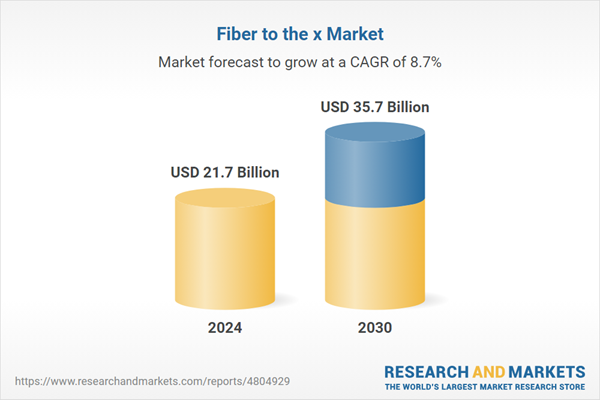The global market for Fiber to the x was valued at US$21.7 Billion in 2024 and is projected to reach US$35.7 Billion by 2030, growing at a CAGR of 8.7% from 2024 to 2030. This comprehensive report provides an in-depth analysis of market trends, drivers, and forecasts, helping you make informed business decisions.
The implementation of FTTx involves the installation of fiber optic cables, which transmit data as light signals, providing superior performance in terms of speed, reliability, and capacity. This infrastructure supports various services, including high-speed internet, VoIP, IPTV, and other advanced telecommunications services. The deployment of FTTx is often part of a broader strategy to upgrade existing telecommunications infrastructure and meet the increasing data consumption demands of modern digital economies. The expansion of FTTx networks requires substantial investment in infrastructure and technology, as well as coordination with regulatory bodies and service providers.
The growth in the FTTx market is driven by several factors. The increasing demand for high-speed internet and data services is a primary driver, fueled by the proliferation of smart devices, cloud computing, and streaming services. Technological advancements in fiber optic technology and network equipment are enhancing the efficiency and cost-effectiveness of FTTx deployments. Government initiatives and policies promoting the development of broadband infrastructure and digital connectivity are also significant drivers, particularly in regions aiming to bridge the digital divide. The rising importance of reliable and high-capacity networks for businesses and residential users alike further supports the expansion of FTTx networks. Additionally, the shift towards remote working and online education, accelerated by the COVID-19 pandemic, has underscored the necessity of robust and high-speed internet connections, boosting the demand for FTTx solutions.
Global Fiber to the x Market - Key Trends & Drivers Summarized
Fiber to the x (FTTx) refers to the deployment of optical fiber infrastructure to various points in a telecommunications network, bringing high-speed broadband services closer to end-users. The 'x' in FTTx denotes different configurations such as Fiber to the Home (FTTH), Fiber to the Building (FTTB), Fiber to the Cabinet (FTTC), and Fiber to the Node (FTTN), depending on how far the fiber extends towards the user premises. FTTx technology offers significantly higher bandwidth and faster internet speeds compared to traditional copper-based networks, supporting the growing demand for data-intensive applications such as video streaming, online gaming, and cloud services.The implementation of FTTx involves the installation of fiber optic cables, which transmit data as light signals, providing superior performance in terms of speed, reliability, and capacity. This infrastructure supports various services, including high-speed internet, VoIP, IPTV, and other advanced telecommunications services. The deployment of FTTx is often part of a broader strategy to upgrade existing telecommunications infrastructure and meet the increasing data consumption demands of modern digital economies. The expansion of FTTx networks requires substantial investment in infrastructure and technology, as well as coordination with regulatory bodies and service providers.
The growth in the FTTx market is driven by several factors. The increasing demand for high-speed internet and data services is a primary driver, fueled by the proliferation of smart devices, cloud computing, and streaming services. Technological advancements in fiber optic technology and network equipment are enhancing the efficiency and cost-effectiveness of FTTx deployments. Government initiatives and policies promoting the development of broadband infrastructure and digital connectivity are also significant drivers, particularly in regions aiming to bridge the digital divide. The rising importance of reliable and high-capacity networks for businesses and residential users alike further supports the expansion of FTTx networks. Additionally, the shift towards remote working and online education, accelerated by the COVID-19 pandemic, has underscored the necessity of robust and high-speed internet connections, boosting the demand for FTTx solutions.
Scope of the Study
The report analyzes the Fiber to the x market, presented in terms of market value (US$ Thousand). The analysis covers the key segments and geographic regions outlined below.Segments:
Architecture (FTTh/p/b, FTTa, FTTn/c/k); Distribution Network (AON, PON); Product (ONT/ONU, OLT, Optical Splitter); Vertical (Commercial, Residential, Industrial).Geographic Regions/Countries:
World; USA; Canada; Japan; China; Europe; France; Germany; Italy; UK; Rest of Europe; Asia-Pacific; Rest of World.Key Insights:
- Market Growth: Understand the significant growth trajectory of the FTTh/p/b segment, which is expected to reach US$16.0 Billion by 2030 with a CAGR of a 8.2%. The FTTa segment is also set to grow at 8.7% CAGR over the analysis period.
- Regional Analysis: Gain insights into the U.S. market, valued at $3.6 Billion in 2024, and China, forecasted to grow at an impressive 9.8% CAGR to reach $9.3 Billion by 2030. Discover growth trends in other key regions, including Japan, Canada, Germany, and the Asia-Pacific.
Report Features:
- Comprehensive Market Data: Independent analysis of annual sales and market forecasts in US$ Million from 2024 to 2030.
- In-Depth Regional Analysis: Detailed insights into key markets, including the U.S., China, Japan, Canada, Europe, Asia-Pacific, Latin America, Middle East, and Africa.
- Company Profiles: Coverage of major players such as AT&T, Inc., Bharat Sanchar Nigam Ltd., ADTRAN, Inc., Alcatel-Lucent Enterprise, Allied Telesis, Inc. and more.
- Complimentary Updates: Receive free report updates for one year to keep you informed of the latest market developments.
Why You Should Buy This Report:
- Detailed Market Analysis: Access a thorough analysis of the Global Fiber, covering all major geographic regions and market segments.
- Competitive Insights: Get an overview of the competitive landscape, including the market presence of major players across different geographies.
- Future Trends and Drivers: Understand the key trends and drivers shaping the future of the Global Fiber.
- Actionable Insights: Benefit from actionable insights that can help you identify new revenue opportunities and make strategic business decisions.
Key Questions Answered:
- How is the Global Fiber expected to evolve by 2030?
- What are the main drivers and restraints affecting the market?
- Which market segments will grow the most over the forecast period?
- How will market shares for different regions and segments change by 2030?
- Who are the leading players in the market, and what are their prospects?
Some of the 102 major companies featured in this Fiber to the x market report include:
- AT&T, Inc.
- Bharat Sanchar Nigam Ltd.
- ADTRAN, Inc.
- Alcatel-Lucent Enterprise
- Allied Telesis, Inc.
- Calix, Inc.
- AFL
- AD-Net Technology Co., Ltd.
- Allied Telesis Holdings KK
- Alfocom Technology Co., Ltd.
- Arcadyan Technology Corporation
- Altibox AS
- Cambridge Industries Group
- 3 EDGE
- Biznet
Table of Contents
I. METHODOLOGYMII. EXECUTIVE SUMMARY2. FOCUS ON SELECT PLAYERSIII. MARKET ANALYSISCANADAJAPANCHINAFRANCEGERMANYITALYUNITED KINGDOMREST OF EUROPEREST OF WORLDIV. COMPETITION
1. MARKET OVERVIEW
3. MARKET TRENDS & DRIVERS
4. GLOBAL MARKET PERSPECTIVE
UNITED STATES
EUROPE
ASIA-PACIFIC
Companies Mentioned (Partial List)
A selection of companies mentioned in this report includes, but is not limited to:
- AT&T, Inc.
- Bharat Sanchar Nigam Ltd.
- ADTRAN, Inc.
- Alcatel-Lucent Enterprise
- Allied Telesis, Inc.
- Calix, Inc.
- AFL
- AD-Net Technology Co., Ltd.
- Allied Telesis Holdings KK
- Alfocom Technology Co., Ltd.
- Arcadyan Technology Corporation
- Altibox AS
- Cambridge Industries Group
- 3 EDGE
- Biznet
Table Information
| Report Attribute | Details |
|---|---|
| No. of Pages | 564 |
| Published | April 2025 |
| Forecast Period | 2024 - 2030 |
| Estimated Market Value ( USD | $ 21.7 Billion |
| Forecasted Market Value ( USD | $ 35.7 Billion |
| Compound Annual Growth Rate | 8.7% |
| Regions Covered | Global |









